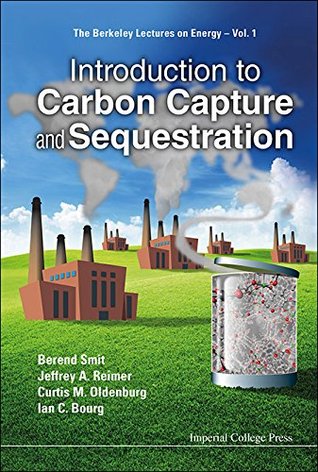Download Introduction to Carbon Capture and Sequestration: 1 (The Berkeley Lectures on Energy) - Berend Smit file in ePub
Related searches:
Introduction to Carbon Capture and Sequestration AIChE
Introduction to Carbon Capture and Sequestration: 1 (The Berkeley Lectures on Energy)
Book: Introduction to Carbon Capture and Sequestration ‒ LSMO
Carbon capture and storage - Wikipedia
Carbon Capture and Storage Technology - an overview
Introduction to Carbon Capture and Sequestration Request PDF
An Introduction to Carbon Capture and Storage Technology
Carbon capture and storage (CCS): the way forward - Energy
Climate Change: Carbon Capture and Storage edX
INTRODUCTION TO CARBON CAPTURE AND SEQUESTRATION (Berkeley
Introduction to Carbon Capture and Sequestration The
Introduction To Carbon Capture And Sequestration (The
Introduction To Carbon Capture And Sequestration by Berend
An introduction to Carbon Capture and Storage Udemy
Introduction to Carbon Capture and Sequestration - EHS Daily
1 Introduction Climate Intervention: Carbon Dioxide Removal and
Carbon Capture Coalition — Center for Climate and Energy Solutions
A TECHNICAL INTRODUCTION TO CARBON CAPTURE AND
Carbon Capture - The Global Climate and Energy Project - Stanford
Introduction: Carbon Capture and Separation
Introduction: Carbon Capture and Separation Chemical Reviews
This is what you need to know about carbon capture and storage
Introduction To Carbon Capture And Sequestration eBook by
Introduction to Carbon Capture, EOR, and Storage
Introduction to carbon capture and sequestration / Berend
GeoSchool - Introduction to carbon capture and storage (CCS
184 1818 4533 1044 1392 1525 3658 201 545
Introduction to carbon capture and sequestration (the berkeley lectures on energy book 1) - kindle edition by berend smit, jeffrey a reimer, curtis m oldenburg, ian c bourg. Download it once and read it on your kindle device, pc, phones or tablets.
Carbon capture and sequestration (ccs) may be an effective way to reduce co2 emissions from power plants and other industrial processes. Its viability is being actively explored throughout the world, including in new york state.
This practice, called carbon capture and sequestration (css), is particularly promising for large emitters, and the environmental protection agency (epa) estimates use of css by power plants burning fossil fuels could reduce co2 emissions by as much as 80-90%.
Introduction: carbon capture and separation c arbon capture and sequestration (ccs) is the only available technology that can reduce the emission of co 2 into the atmosphere due to burning of fossil fuels.
Oct 13, 2014 the companies in which royal dutch shell plc directly and indirectly owns investments are separate entities.
Abstract: there is nothing magical about carbon capture and storage (ccs). The technology to capture and store co 2 in geological formations is already available commercially.
62 kb file count 1 create date 22/06/2020 last updated 22/06/2020 geoschool - introduction to carbon capture and storage (ccs).
This is followed by a description of the technologies available to capture carbon (post combustion capture, capture by oxyfuel combustion, and pre combustion capture) and their level of readiness together with the benefits of geological storage and mechanisms that trap the co2 underground (geological trapping, co2 dissolution in water, residual trapping and mineral trapping).
Request pdf introduction to carbon capture and sequestration the aim of the book is to provide an understanding of the current science underpinning.
Carbon capture and storage (ccs) is broadly recognised as having the an introduction to co2 capture technologies, with an overview of solvent-based.
The carbon referred to here is the greenhouse gas carbon dioxide (co 2), which is emitted when we, for example, burn oil, coal or gas and when.
Apr 29, 2020 of tonnes of carbon emissions to be captured by power generators and industry� read on for our introduction to carbon capture and storage.
Public perception of ccs; ccs technological overview; ccs challenges and solutions. Muir glacier global carbon dioxide emissions from electricity in 2007.
Introduction to carbon capture and sequestration available in hardcover, paperback, nook book.
Princeton university library one washington road princeton, nj 08544-2098 usa (609) 258-1470.
) speak at the introduction of a senate bill to increase incentives for carbon capture projects.
Carbon capture, utilization and storage (ccus), also referred to as carbon capture, utilization and sequestration, is a process that captures carbon dioxide.
The atmosphere is a shared resource and the amount of greenhouse gases it can absorb is a finite resource.
Carbon capture and storage (also known as carbon capture and sequestration) aims to lower atmospheric co2 by stopping carbon from being released.
By berend smit,jeffrey a reimer,curtis m oldenburg,ian c bourg. The berkeley lectures on energy (book 1) thanks for sharing! you submitted the following rating and review.
For more than three decades, scientists have predicted that a doubling of carbon dioxide in earth's atmosphere from preindustrial levels would.
This assessment provides an overview of carbon capture technologies, organized by the physical.
Carbon dioxide (co2) is a greenhouse gas that occurs naturally in the this introductory section presents the general framework for the assessment together.
Carbon capture and storage (ccs), or carbon capture and sequestration and carbon control and sequestration, is the process of capturing waste carbon dioxide.
Carbon capture and sequestration (ccs) is the only available technology that can reduce the emission of co 2 into the atmosphere due to burning of fossil fuels. Our addiction to fossil fuels started with the industrial revolution. It is clear that the earth temperature has a direct dependence on the co 2 concentration, and an increase in the average globa.
Oct 17, 2020 carbon capture and storage (ccs) technology has been recognized as the most effective method to reduce carbon dioxide (co2) released into.

Post Your Comments: